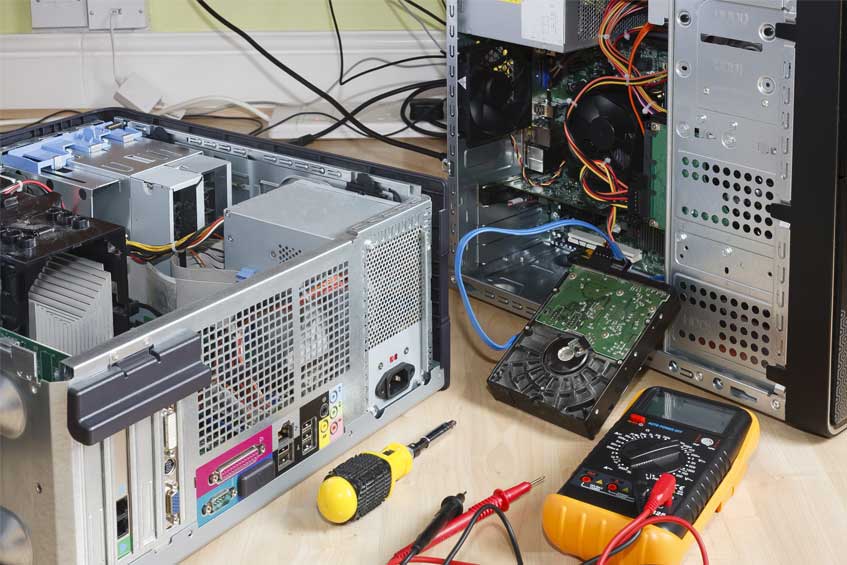Illuminating the Darkness: A Comprehensive Guide to Resurrecting a PC That Refuses to Turn On

Introduction:
The frustration of pressing the power button on your PC only to be met with resounding silence or an unresponsive screen is a familiar scenario for many users. A PC that refuses to turn on can be a perplexing and disheartening experience, leaving you wondering about the potential causes and solutions. In this extensive guide, we will navigate through the labyrinth of possibilities, exploring the diverse reasons why a PC may not turn on and providing a comprehensive array of solutions to revive your silent companion.
Section 1: Diagnosing the Problem – Common Causes of PC Power Failures
1.1 Power Supply Issues
The power supply unit (PSU) is the lifeblood of your PC, converting electrical energy into a form usable by the components. We’ll explore how power supply issues, such as a faulty PSU or loose connections, can lead to a non-responsive PC.
1.2 Motherboard Failures
The motherboard serves as the central hub, orchestrating communication between various components. We’ll discuss how motherboard failures, whether due to physical damage or internal issues, can result in a non-functioning PC.
1.3 Faulty RAM Modules
Random Access Memory (RAM) is crucial for your PC’s short-term memory. We’ll examine how faulty RAM modules can prevent the system from initializing properly, leading to a failure to turn on.
1.4 CPU Malfunctions
The Central Processing Unit (CPU) is the brain of your PC. We’ll explore how CPU-related issues, including overheating or physical damage, can contribute to a non-starting computer.
1.5 Graphics Card Problems
A malfunctioning graphics card can hinder the visual output and prevent the PC from booting. We’ll discuss how to identify graphics card issues and their impact on the overall system.
1.6 Storage Device Failures
Issues with storage devices, such as hard drives or solid-state drives, can impede the boot process. We’ll delve into how failing storage devices can lead to a PC that won’t turn on.
1.7 External Factors – Power Outages and Surges
External factors like power outages and surges can have a significant impact on your PC’s health. We’ll explore how these events can contribute to power-related failures and what preventative measures can be taken.
Section 2: The Step-by-Step Resurrection Guide
2.1 Check Power Connections
A loose power cable or improperly connected components can be a simple yet common cause of power failures. We’ll guide you through checking and securing all power connections to ensure a stable power supply.
2.2 Test the Power Outlet
A malfunctioning power outlet can render your PC powerless. We’ll discuss how to test the power outlet and explore potential solutions if an issue is identified.
2.3 Inspect the Power Supply Unit (PSU)
The PSU is a critical component, and issues with it can lead to power failures. We’ll guide you through inspecting the PSU for visible damage and testing its functionality.
2.4 Perform a “Paperclip Test” on the PSU
The paperclip test is a diagnostic method to check the basic functionality of the PSU. We’ll provide step-by-step instructions on performing this test and interpreting the results.
2.5 Reseat RAM Modules
Loose or improperly seated RAM modules can prevent your PC from starting. We’ll discuss how to safely reseat RAM modules to ensure proper connections.
2.6 Check for CPU Issues
CPU-related problems can impede the boot process. We’ll explore how to troubleshoot potential CPU issues, including overheating and physical damage.
2.7 Inspect the Motherboard
A malfunctioning motherboard can be a complex issue to diagnose. We’ll guide you through inspecting the motherboard for physical damage and exploring potential solutions.
2.8 Test the Graphics Card
A faulty graphics card can prevent visual output and lead to a non-responsive PC. We’ll discuss how to test the graphics card and troubleshoot related issues.
2.9 Disconnect External Devices
Peripheral devices may contribute to power failures. We’ll guide you through disconnecting external devices and testing the PC to identify potential culprits.
2.10 Use a Minimal Hardware Setup
Creating a minimal hardware setup can help isolate the cause of power failures. We’ll discuss the process of assembling a bare-bones system for troubleshooting.
2.11 Boot from an External Source
Booting from an external source can help determine if the issue lies with the internal storage devices. We’ll guide you through the process of creating a bootable USB drive for testing.
2.12 Test and Replace Storage Devices
Faulty storage devices can hinder the boot process. We’ll discuss how to test and replace storage devices if necessary.
Section 3: Advanced Troubleshooting and Professional Assistance
3.1 BIOS/UEFI Configuration
Adjusting BIOS/UEFI settings can sometimes resolve boot issues. We’ll discuss advanced troubleshooting steps within the BIOS/UEFI interface.
3.2 Clear CMOS
Clearing the CMOS can reset motherboard settings to default. We’ll guide you through the process and explore situations where this step may be beneficial.
3.3 Professional Diagnostic Tools
Professional diagnostic tools can provide in-depth insights into hardware issues. We’ll discuss popular tools and their applications in identifying the root cause of power failures.
3.4 Seek Professional Assistance
If DIY troubleshooting proves inconclusive, seeking professional assistance may be necessary. We’ll discuss scenarios where professional technicians can provide expertise and specialized diagnostics.
Section 4: Preventative Measures and Best Practices
4.1 Regular System Maintenance
Regular maintenance practices can prevent hardware issues. We’ll discuss tasks such as cleaning, proper ventilation, and routine inspections to keep your PC healthy.
4.2 Surge Protectors and Uninterruptible Power Supplies (UPS)
Surge protectors and UPS devices can safeguard your PC against power-related issues. We’ll discuss the importance of these protective measures and how they work.
4.3 Regular Backups
Regularly backing up your data is essential for safeguarding important files. We’ll discuss backup strategies and tools to ensure your data is secure.
4.4 Quality Components and Upgrades
Investing in quality components and timely upgrades can prolong your PC’s lifespan. We’ll explore considerations for selecting components and planning upgrades.
Conclusion:
A PC that refuses to turn on can be a perplexing challenge, but armed with the knowledge and troubleshooting techniques outlined in this comprehensive guide, you have the tools to diagnose and resolve the issue. From checking power connections to advanced troubleshooting steps, this guide covers a spectrum of possibilities, empowering you to resurrect your silent companion. Remember, patience and systematic troubleshooting are key as you navigate through the steps. So, embark on the journey to revive your PC, unravel the mysteries of its non-starting state, and bask in the satisfaction of a successfully resurrected system.




